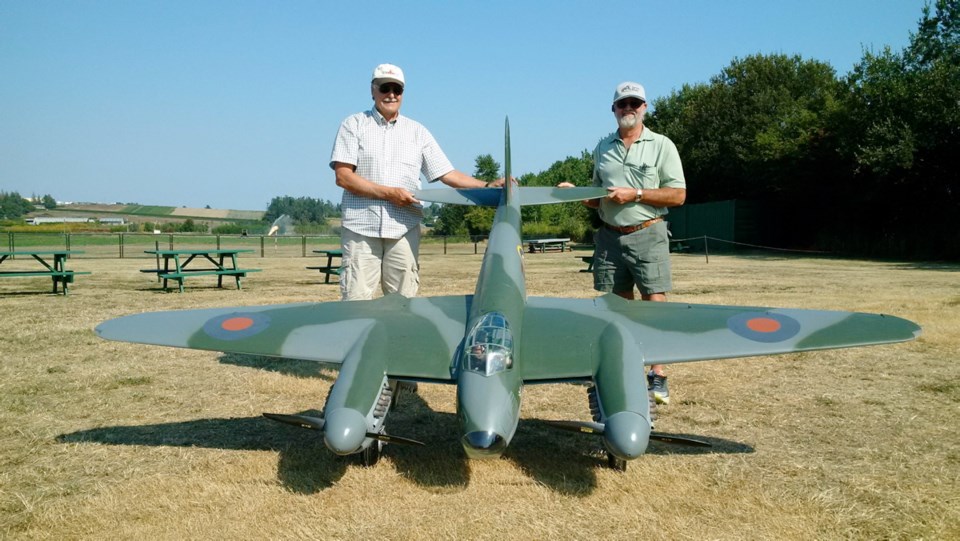An air force is stationed in Victoria whose pilots never leave the ground but are united in their love of aircraft and watching them fly.
They are the 55-odd members of the Victoria Radio Controlled Model Society, who devote themselves to building and flying model aircraft.
They fly their models from their own airfield, Michell Airfield, on Lochside Drive near Island View Road.
The club operates it under an agreement with landowners Michell Farms.
And they regularly put on public events, such as the Largest Little Air Show staged recently, and raise tens of thousands of dollars for CFAX Santa’s Anonymous and the Saanich Peninsula Hospital Foundation.
The latest event raised a total of $28,000 for charity, and over its 14 years it has raised more than $213,000.
The models built by society members are a long way ahead of the gliders or rubber-band powered models still beloved by kids. Also, since they can fly, they are in a different category than the popular and often plastic display models sold at toy stores.
For a start, the RC models are big. Scaling a real aircraft down to something like 1/5 or 1/6 scale still results in a replica with a wing span of several metres.
Also, despite the name “model,” they should be counted as real aircraft. They are powered by real propulsion systems: battery-powered electric motors, gasoline-fired internal-combustion engines and even real gas turbines to drive the jet aircraft. And their flight is directed by radio control from the ground.
The model planes cost anywhere from a few hundred to tens of thousands of dollars. There are also thousands of hours spent building the planes, tweaking their aerodynamics and practising flying techniques.
Jack Price, a society member, private pilot and flyer of some of the club’s most spectacular aircraft, said it’s just a good fit for him.
“If you love aircraft and you are interested in flight and you happen to like building things, then it’s almost natural to get into models,” Price said.
His collection includes aircraft with wing spans of several metres, like his Corsair, a replica of the Second World War fighter. He also has an amazing, realistic 1/6 version of a twin-engine jet, A-10 “Warthog” ground support aircraft that flew in Middle East conflicts, including the two recent Iraq wars.
Right now, Price is putting finishing touches on another replica jet, a Starfighter, decked out in colours of the Royal Canadian Air Force.
Club members at the air show say the hobby got a big boost about 10 to 15 years ago when battery technology improved and the size of the power-storing units shrank. Suddenly, electric motors became a reliable option for model aircraft.
Without the risks, smell or mess posed by flammable fuels, electric motors were more attractive to many hobby flyers.
For many purists, however, nothing beats the sound of a real four-stroke engine or the kerosene smell of jet fuel driving a turbine.
Many of these model aircraft begin as kits. But club members say there is a long way and many hours from a kit in a box to a flying the aircraft.
They are often advertised as “Almost Ready to Fly,” or “arf” in model aircraft jargon. But opening up a box often presents a buyer with little more than planks of balsa wood and sticks and plans.
Also, while scale replicas occupy many of the society’s enthusiasts, the hobby has other categories, with models specifically designed with nothing more than flight in mind.
These ones aren’t designed to look like any particular full-size aircraft. They are meant for stunt flights or even racing around pylons while their pilots work the radio controls.
Mike Scholefield, another member of the society, began his modelling with remote-controlled model yachts. But after moving from Ontario, he found few who shared his interest.
So Scholefield switched to planes and quickly found a community of enthusiasts who approached the hobby as seriously as he did with the yachts.
The society offers flight training for radio-controlled model lovers and insists members keep up credentials. It also does its best to maintain good relations with the neighbours around Michell Airfield. They are well versed in Transport Canada regulations and carry insurance.
“There are lots of guys around who fly from school fields,” said Scholefield. “But we have rules and not everyone likes to follow the rules.”
“It’s like golf, there are rules but you can still play by yourself,” he said. “Every time you go up in the air, you are flying against yourself.”



